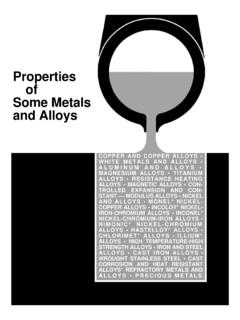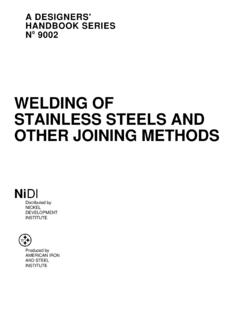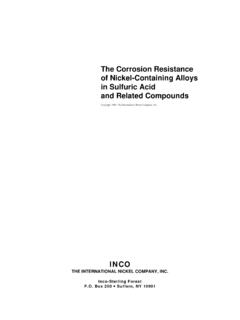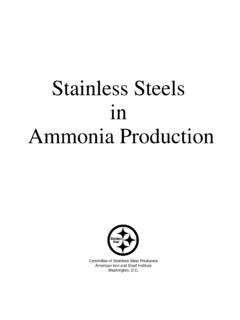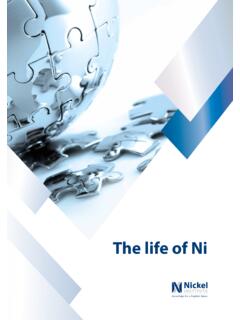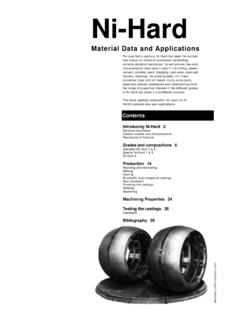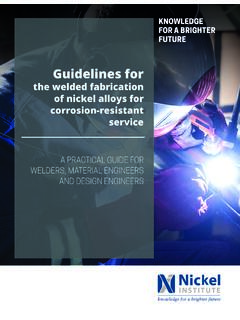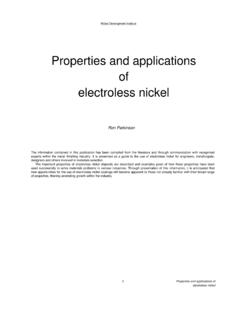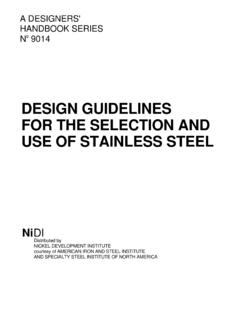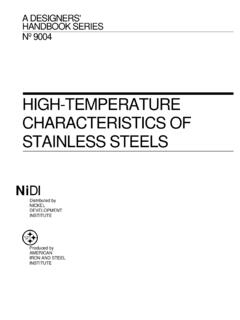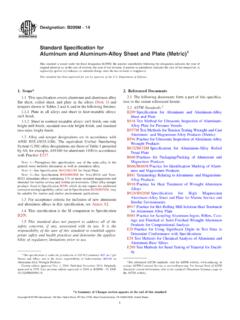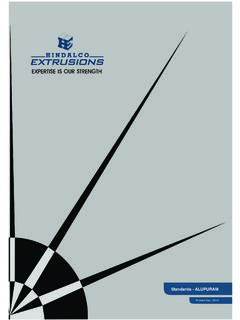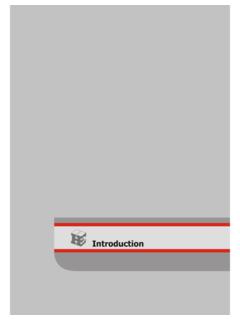Transcription of Stainless Steels: An Introduction to Their Metallurgy and ...
1 Dairy, Food and Environmental Sanitation, Vol. 20, No. 7, Pages 506-517 Copyright International Association for Food Protection, 6200 Aurora Ave., Suite 200W, Des Moines, IA 50322 Stainless Steels: An Introduction to Their Metallurgy and Corrosion Resistance Roger A. Covert and Arthur H. Tuthill* This article has been peer-reviewed by two professionals. Introduction Worldwide, in industry, in busi-ness and in the home, metals called Stainless steels are used daily. It is important to understand what these materials are and why they behave the way they do. This is especially true because the word Stainless is itself somewhat of a misnomer; these materials can stain and can corrode under certain conditions. People need to know why these metals are usually bright and shiny and why they sometimes depart from this expected appearance.
2 In this paper, we hope to explain some of these phenomena and provide a 506 Dairy, Food and Environmentol Sanitation - JULY 2000 better understanding of Stainless steels, especially to the non-metal-lurgist. Industries are concerned with integrity of equipment and product purity. To achieve these, Stainless steels are often the economical and practical materials of choice for pro-cess equipment. However, before intelligent decisions can be made regarding the proper selection from the various types of Stainless steel, it is necessary to have an understanding of what Stainless steels are. It is important to know what different grades of Stainless steel are available, why they perform satisfactorily and why they sometimes do not. In most cases, selection of the proper Stainless steel leads to satisfactory performance.
3 COMPOSITION, NOMEN- CLATURE AND GENERAL PROPERTIES Most metals are mixtures of a primary metallic element and one or more intentionally added other ele-ments. These mixtures of elements are called alloys. Stainless steels are alloys, as are brasses (copper + zinc), bronzes (copper + tin), the many alu-minum alloys, and many other me-tallic materials. In general, solid metals and alloys consist of randomly oriented grains that have a well-de-fined crystalline structure, or lattice, within the grains. In Stainless steels, the crystalline structures within the grains have been given names such as ferrite, austenite, martensite, or a mixture of two or more of these. Many of the properties of Stainless steels depend upon which crystalline lattice occurs. Examples of these crystal structures are given in Fig.
4 1, where the black dots represent atoms and the lines are present to help the structure to be seen. Figure 1. Crystal structures of Stainless steels Figure 2. The influence of chromium on the atmospheric corrosion of low carbon steel Ferrite is the basic crystal struc-ture of iron or low-alloy steel at am-bient temperatures. To understand it, envision a cube with an atom at each of the eight corners and in the geo-metric centre of the cube. This body-centred cubic structure (Fig. 1a) is repeated regularly in three dimensions throughout the grain until it meets a grain of different orientation. At these contacts are areas termed grain boundaries. Grain boundaries consist of many things, including the interface, defects, impurities and grains of other substances. They can be quite complicated and often play an important role in the mechanical properties and corrosion behaviour of metals.
5 Austenite is the crystal form of unalloyed iron in the grains at higher temperature (>800 C). It is different from ferrite. As in ferrite, there is an atom at each corner of a cube, but instead of one in the geometric centre, there is one in the centre of each of the six faces of the cube. This face-centred cubic array (Fig. 1b) becomes stable at room temperature if nickel, manganese, nitrogen, or carbon is added, singly or in combination, to iron or iron/ chromium alloys. The resulting ma-terials are called austenitic Stainless steels. In general, they are easier to shape and bend, more weldable, and less brittle than ferritic alloys. Martensite is a stable structure at ambient temperature and more similar to ferrite than to austenite. It also has a body-centred structure (Fig.)
6 1c), but one axis of the cube has been elongated to form a tetragonal structure, that is, a crystal having all three axes at right angles and with two equal sides and one unequal. It is produced by heat treat-ing or cold working cubic crystals of ferrite or austenite. Martensite is the hardest, and strongest of the three crystalline forms, but it is also the least workable. In fact, these alloys are seldom intentionally deformed. As mentioned previously, alloys are combinations of two or more elements, at least one of which is always a metal. All of the many and varied Stainless steels are alloys. They are always iron-chromium alloys, but they often contain other elements, such as molybdenum or nickel. The better known varieties of Stainless steel are wrought (hot- rolled or hot-forged after casting into an ingot).
7 There are also cast counterparts that have properties similar to those of most of the wrought grades but that are altered slightly in composition in order to improve casting properties. To define the different materials, the publication Metals and Alloys in the Unified Numbering System (1) lists over 250 types within the broad definition of Stainless steels. These are iron base alloys containing more than 11% chromium. Various grades also contain nickel, molybdenum, manganese, nitrogen and other alloying elements. As can be seen in Fig. 2 (6), chromium's primary effect is to impart corrosion resistance. The diagram shows the influence of chromium on corrosion when it is added to iron or steel. As can be seen, when it reaches JULY 2000 - Dairy, food and Environmental Sanitation 507 Figure 3.
8 Effect of adding nickel to Fe-Cr alloys 11-14%, corrosion is practically negligible in the atmosphere. Nickel in Stainless steel promotes austenite stability and reduces the temperature at which austenite can exist. Figure 3 illustrates this effect. Above the diagonal line in the diagram, austenite is stable at the indicated temperature; below the line, either ferrite or martensite is the stable crystal structure. Manganese is similar to nickel when it is added to or substituted for nickel and also increases strength. Molybdenum increases the resistance to localized corrosion phenomena, such as pitting and crevice corrosion. Nitrogen also improves resistance to crevice corrosion, as well as increasing strength and acting as an austenite stabilizer. Elements such as copper and silicon improve corrosion resistance in special environments, and silicon also improves casting properties.
9 To reduce confusion and sim-plify nomenclature, standard numbering systems have been developed for the various Stainless steel alloys. For many years in the United States, the three-digit method of the American Iron and Steel Institute (AISI) was common for wrought Stainless steels. Another letter and number system, that of the Alloy Casting 508 Dairy, Food and Environmental Sanitation - JULY 2000 Institute, applied to the cast grades. These early systems divided Stainless steel alloys into groups according to crystal structure. However, many of the newer alloys did not fit into the earlier categories, and it became necessary to have a more complete system. Therefore, these older nomenclatures are now being replaced by the, Unified Numbering System (UNS)(1) developed by the Society for Automotive Engineers (SAE) and the American Society for Testing and Materials (ASTM).
10 These groups have developed a six-character notation that assigns a unique designator to metals and alloys in a way that consistently defines a material. For example, the UNS number S30403 replaces AISI 3041; the final two digits, 03, indicate the maximum permitted carbon content. In other alloys, the various digits may refer to other parameters; so it cannot always be assumed that the latter numbers mean carbon content. The equivalent cast alloy is J92500, which formerly was ACI CF-3. It should also be noted that the letter before the numbers in the Unified Numbering System pertains to different alloy classes. All letters used will not be defined here, but those of importance will be mentioned. The S refers to heat and corrosion steels (including Stainless steels), valve steels and iron-base superalloys , the J to cast steels (except tool steels), and N to nickel and nickel alloys.
